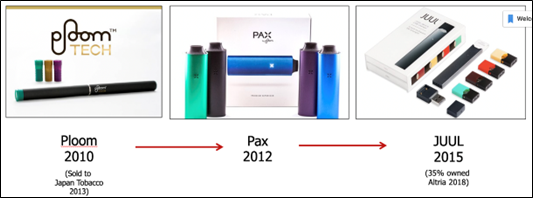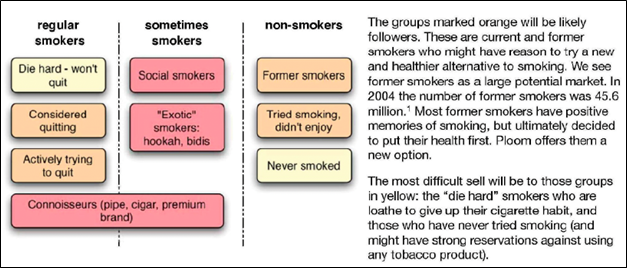Juul co-founders Adam Monsees and James Bowen portray themselves as idealistic entrepreneurs committed to improving the health of billions of adult smokers with no intent to sell nicotine to non-smokers. Documents released as part of the settlement of North Carolina’s lawsuit against Juul, however, tells quite a different story.

In particular, Monsees & Bowen’s 2006 prospectus – Ploom phase- C implementation plan saw former smokers and even non-smokers as important markets for Ploom, a heated tobacco product that was a precursor to Juul.
Here are excerpts from the marketing plan that highlight the fact that they saw the market extending well beyond current smokers:



In March 6, 2007, Ploom planned market focus included recruiting former smokers and non-smokers. The market focus description includes: “non-smokers” and “We see former smokers as a large potential market.” The plan goes on to say: “In 2004 the number of former smokers was 45.6 million. Most former smokers have positive memories of smoking, but ultimately decided to put their health first.” While Monsees and Bowen may not have been aware of it, holding on to health-concerned smokers was also Philip Morris’ goal when it started developing its own e-cigarette in the early 1990s.
Monsees and Bowen were, however, aware of earlier unsuccessful efforts by RJ Reynolds’ Premier and Eclipse and Philip Morris’ Accord heated tobacco products:
Neither of these projects met any real commercial success, and there is currently no product on the market that is remotely comparable to Ploom. We see this as a failure of vision and design insight on the part of the tobacco companies. They have been limited by their goal of creating a “safe cigarette.” Our goal is to create an equally attractive alternative that doesn’t replace the cigarette, but opens up a new category of product for smokers and non-smokers alike. [italic emphasis added]
History would show that successor product Juul would go on to be wildly successful at attracting never smokers, particularly kids.
Monsees and Bowen also saw Ploom as a way around clean indoor air restrictions and as a way to restore the social acceptability of public tobacco use. This recognition reinforces the importance of including e-cigarettes and heated tobacco products in clean indoor air laws and educating the public about the fact that these products still force bystanders to breathe in the toxic chemicals that users exhale.
Thanks to Robert Jackler, creator of the Sanford Research into the Impact of Tobacco Advertising Collection, for bringing this document to my attention. This blog post is an adaptation and expansion of material he sent me.
The full Plan C implementation plan is available here.
Boom! 💣💥You nailed them. Excellent presentation.
Sent from my iPhone
<
div dir=”ltr”>
<
blockquote type=”cite”>
LikeLike
Wow – completely different from the Netflix JUUL.
Thanks, Stan,
Judith
LikeLike
As is often the case with documents: it’s something we all knew but couldn’t prove, and then BAM! It’s right here in this document.
What they say in private when they think no one is listening.
LikeLike